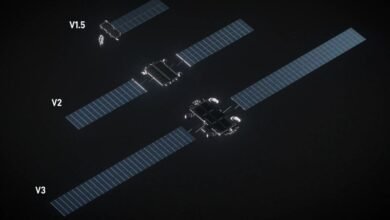Google’s Plan to Launch AI Data Centers in Space

▼ Summary
– The tech industry is rapidly building AI data centers but faces high energy costs and logistical issues, prompting interest in space-based infrastructure.
– Google is developing Project Suncatcher, a “moonshot” initiative to create scalable networks of orbiting TPUs (AI accelerators) in space.
– Space-based AI compute benefits from solar power, with satellites in sun-synchronous orbits providing nearly constant sunlight and up to eight times more efficient solar energy than on Earth.
– High-speed communication between orbiting satellites is a challenge, requiring wireless solutions capable of tens of terabits per second, with early tests achieving 1.6 Tbps.
– Google compares the project’s long development timeline to its self-driving car evolution, acknowledging significant engineering hurdles before Project Suncatcher becomes reality.
The technology sector is aggressively expanding its artificial intelligence infrastructure, constructing data centers at a rapid pace. Google is now exploring a radical new frontier for this expansion: space. The immense energy demands and complex logistics of terrestrial facilities have spurred interest in orbital solutions. Visionaries including Jeff Bezos and Elon Musk have previously speculated about deploying computing hardware beyond Earth’s atmosphere. Google has officially confirmed its own ambitious initiative, dubbed Project Suncatcher, which aims to create scalable networks of orbiting Tensor Processing Units (TPUs).
Earth’s orbital environment has undergone a significant transformation in recent years. The successful deployment of massive satellite constellations, such as Starlink, has proven the viability of using orbital systems for global internet communication. Applying a similar model to position high-performance AI accelerators in space could provide a tremendous advantage for the industry’s continuous growth. Google has stated its belief that the cosmos might represent the optimal location for scaling artificial intelligence computational power.
The blueprint for these scalable orbital data centers involves solar-powered satellites interconnected by free-space optical links, forming a vast distributed network. Of course, numerous formidable engineering obstacles must be overcome before Project Suncatcher becomes a reality. Google draws a parallel to its own history, referencing the lengthy fifteen-year journey from its initial self-driving car experiments to the nearly fully autonomous Waymo vehicles operating today.
Relocating AI processing to space offers several clear benefits. According to a pre-print study outlining the Suncatcher concept, the satellites would occupy a dawn-dusk, sun-synchronous low-earth orbit. This specific trajectory guarantees they receive nearly continuous sunlight, which inspired the project’s name. The high cost of electricity is a significant burden for large terrestrial data centers, and even transitioning entirely to ground-based solar power presents limitations. Google highlights that solar panels achieve up to eight times greater efficiency in the vacuum of space compared to their performance on Earth. Abundant, uninterrupted sunlight combined with this heightened efficiency translates into substantially more power for intensive data processing tasks.
A critical challenge involves maintaining high-speed connectivity between satellites as they travel in orbit. In conventional Earth-based data centers, nodes communicate using extremely fast optical interconnect chips. Achieving similar high-speed communication between orbiting servers will demand advanced wireless solutions capable of operating at speeds reaching tens of terabits per second. Early ground-based testing has already demonstrated promising bidirectional speeds of up to 1.6 Tbps, and Google is confident these rates can be progressively increased to meet future demands.
(Source: Ars Technica)
